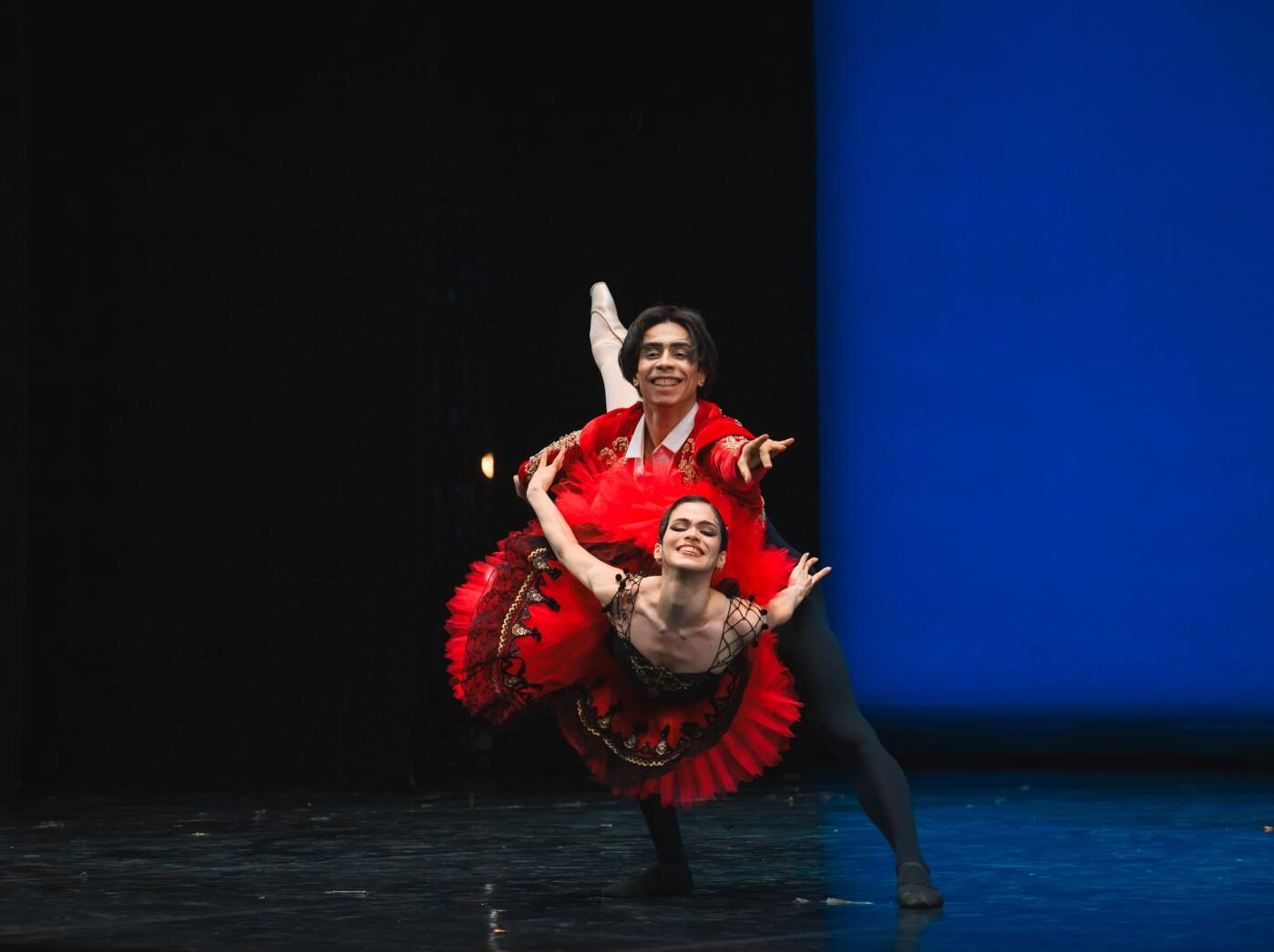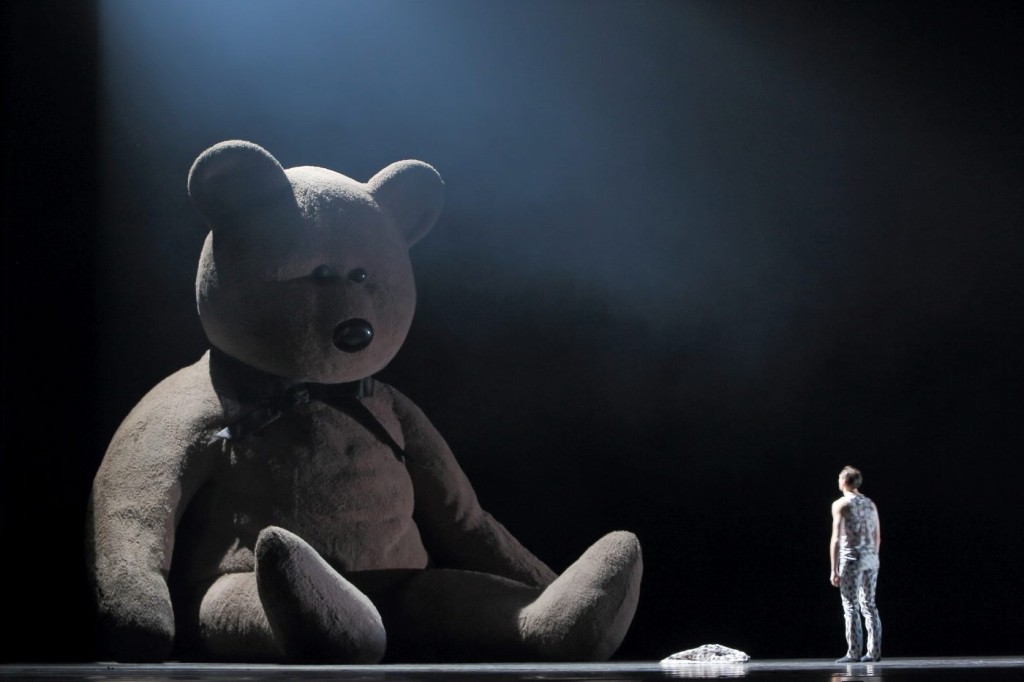“Symphony in C / In the Night / Adam is”
Bavarian State Ballet
National Theater
Munich, Germany
December 28, 2015
by Ilona Landgraf
Copyright © 2016 by Ilona Landgraf
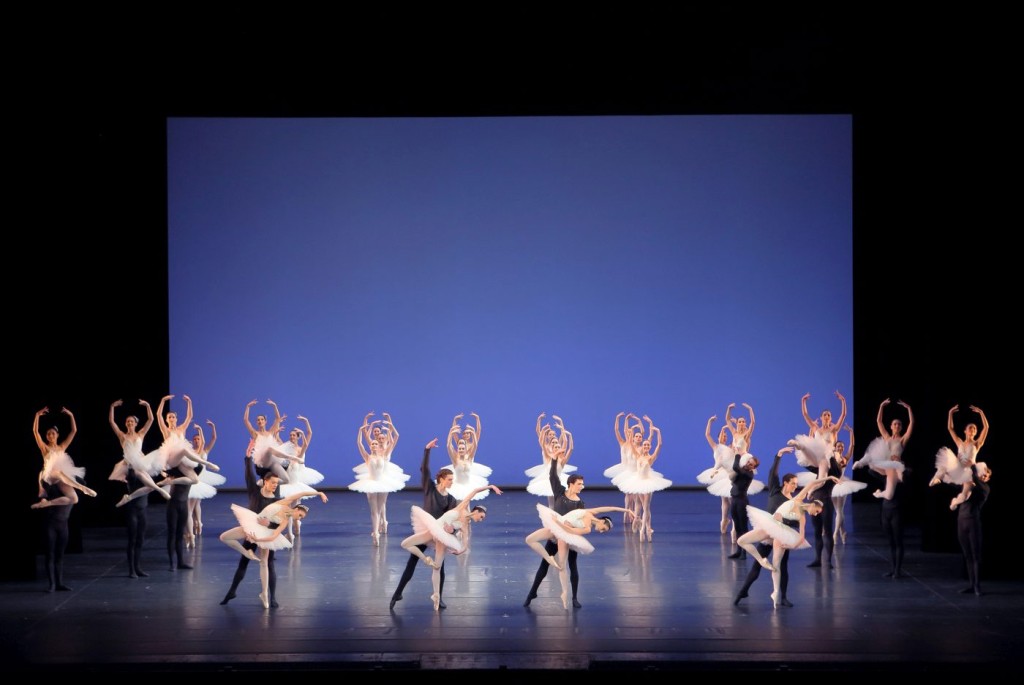 Juxtaposing established choreography and contemporary work can be intriguing. Yet comparing and contrasting a new piece with those of the masters also carries risks. The Bavarian State Ballet’s new evening of ballet dares to do this. It combines George Balanchine’s “Symphony in C” and Jerome Robbins’s “In the Night” with “Adam is” – a fresh dance by Canada’s Azure Barton. Did the assemblage work?
Juxtaposing established choreography and contemporary work can be intriguing. Yet comparing and contrasting a new piece with those of the masters also carries risks. The Bavarian State Ballet’s new evening of ballet dares to do this. It combines George Balanchine’s “Symphony in C” and Jerome Robbins’s “In the Night” with “Adam is” – a fresh dance by Canada’s Azure Barton. Did the assemblage work?
“Symphony in C”, choreographed in 1947 for the Paris Opera Ballet, was originally titled “Le Palais de Cristal”. Accordingly it is luminous, pleasing the eyes with large numbers of white tutus, which contrast with dark, close-fitting tights and shirts for 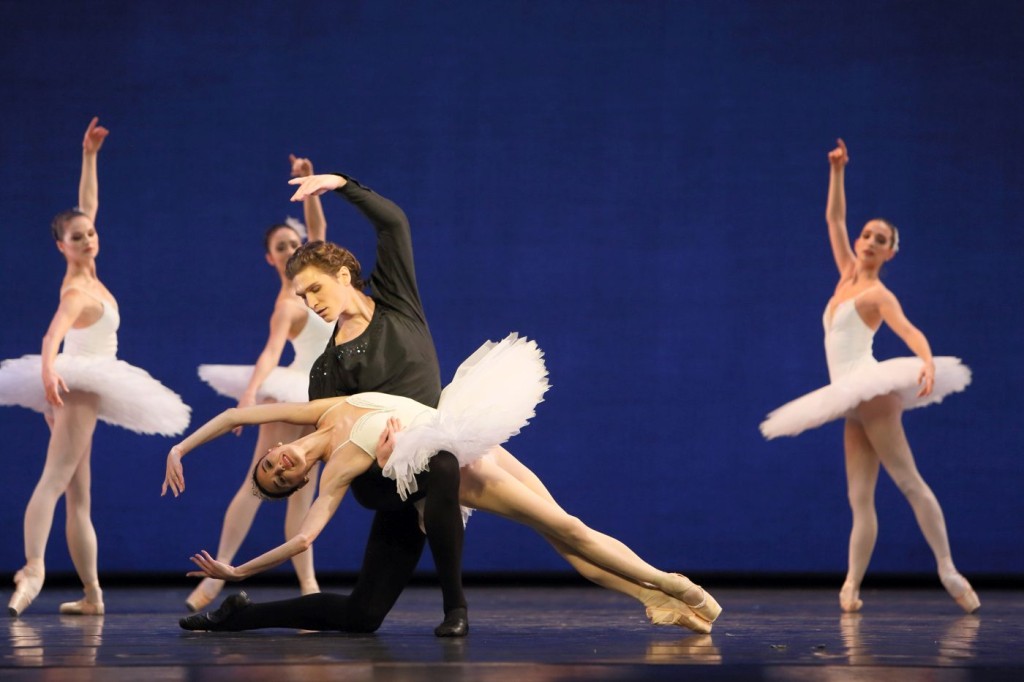 the men. It has aspects of a brisk, brightly lit version of “Swan lake”. Later Balanchine renamed the piece, adopting the title of its music which is by Georges Bizet. Its four movements involve a great number of dancers, most of them female. Each movement has its corps, soloists and a central male/female couple. The corps not only serves as a frame but actually dances the entire time as well. Sure-fire technique, speed, accuracy and timing are essential to master Balanchine’s challenges. The corps’s remarkable, mirror-imaged spatial patterns expose every little lapse.
the men. It has aspects of a brisk, brightly lit version of “Swan lake”. Later Balanchine renamed the piece, adopting the title of its music which is by Georges Bizet. Its four movements involve a great number of dancers, most of them female. Each movement has its corps, soloists and a central male/female couple. The corps not only serves as a frame but actually dances the entire time as well. Sure-fire technique, speed, accuracy and timing are essential to master Balanchine’s challenges. The corps’s remarkable, mirror-imaged spatial patterns expose every little lapse.
Dancing the second performance after the premiere, the Bavarians did not deliver any bravura coup but did very well. The first movement, the Allegro vivo, looked tense at the beginning, yet gradually gained liveliness. It was led by Ekaterina Petina 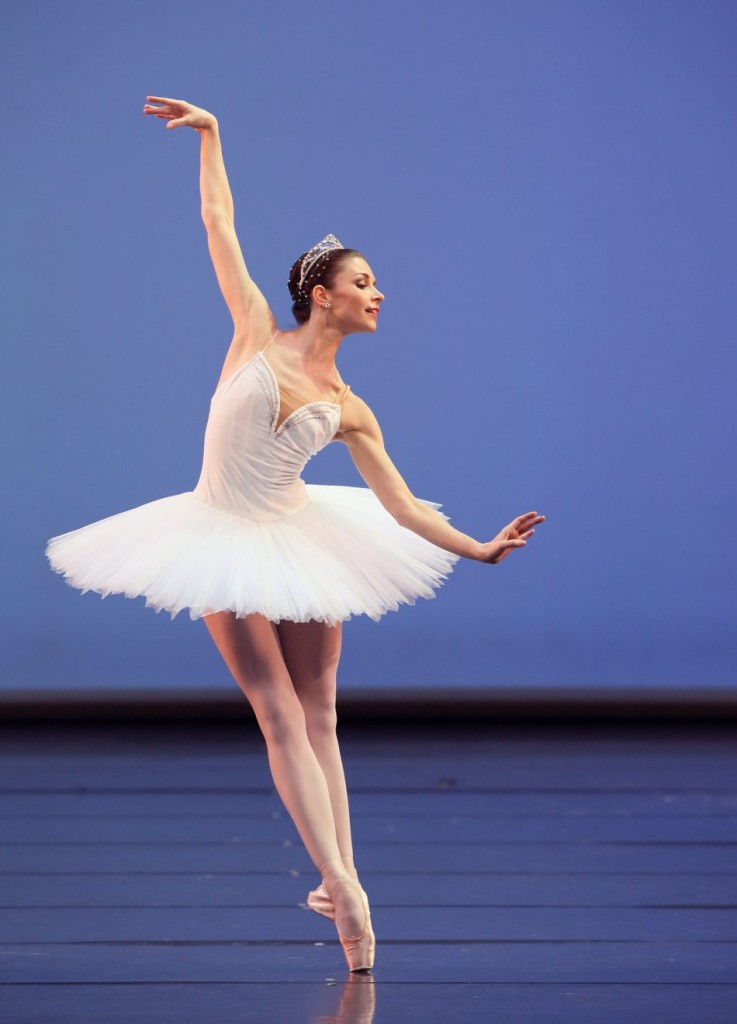
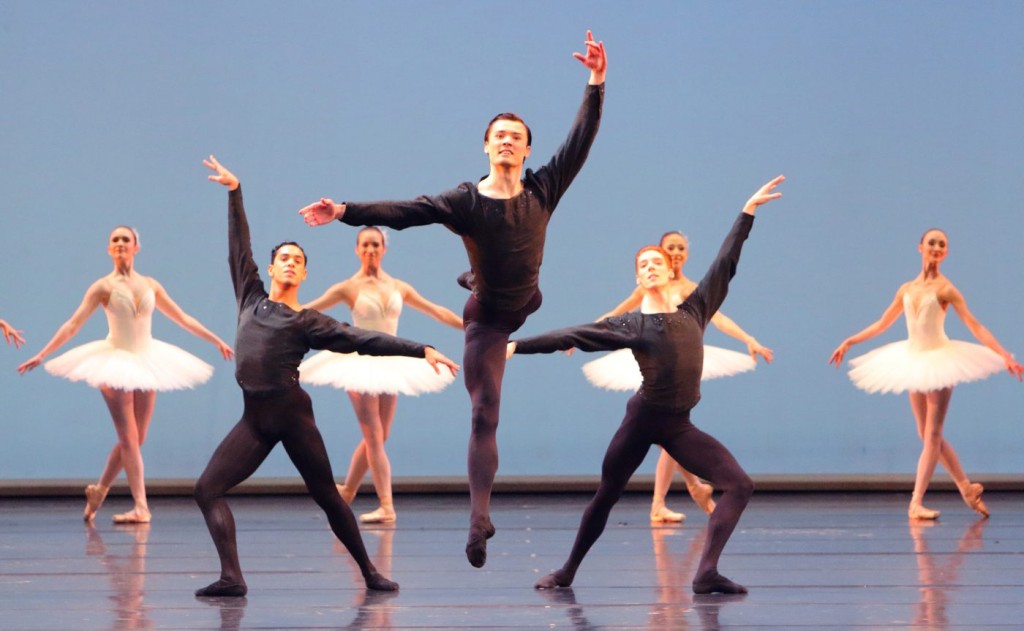 and Erik Murzagaliyev. Daria Sukhorukova and Cyril Pierre mastered the second movement, the adagio, which is the heart of the whole ballet. The composure of both along with their intense facial expressions underscored the sentimentality inherent in their parts. Sukhorukova easily mastered poised balances in the side développés and the penché. The third movement, (Allegro vivace), extremely fast and involving much jumping, was ideal for the quicksilvery and buoyant Iva Amista partnered by Maxim Chashchegorov. Petite Katherina Markowskaja, paired with Adam Zvonař, spun nimbly through the fourth movement (Allegro vivace). The rousing finale gathering all fifty-two dancers on stage looked spectacular!
and Erik Murzagaliyev. Daria Sukhorukova and Cyril Pierre mastered the second movement, the adagio, which is the heart of the whole ballet. The composure of both along with their intense facial expressions underscored the sentimentality inherent in their parts. Sukhorukova easily mastered poised balances in the side développés and the penché. The third movement, (Allegro vivace), extremely fast and involving much jumping, was ideal for the quicksilvery and buoyant Iva Amista partnered by Maxim Chashchegorov. Petite Katherina Markowskaja, paired with Adam Zvonař, spun nimbly through the fourth movement (Allegro vivace). The rousing finale gathering all fifty-two dancers on stage looked spectacular!
The piece, which was last in the Bavarian State Ballet’s repertory in 1975, will need time to become second nature to the current company. Yet it is absolutely worth every effort, not only for the dancers to hone their skills but simply because it is ravishing to watch. It is one of the greatest and most influential dance works of the post-war era.
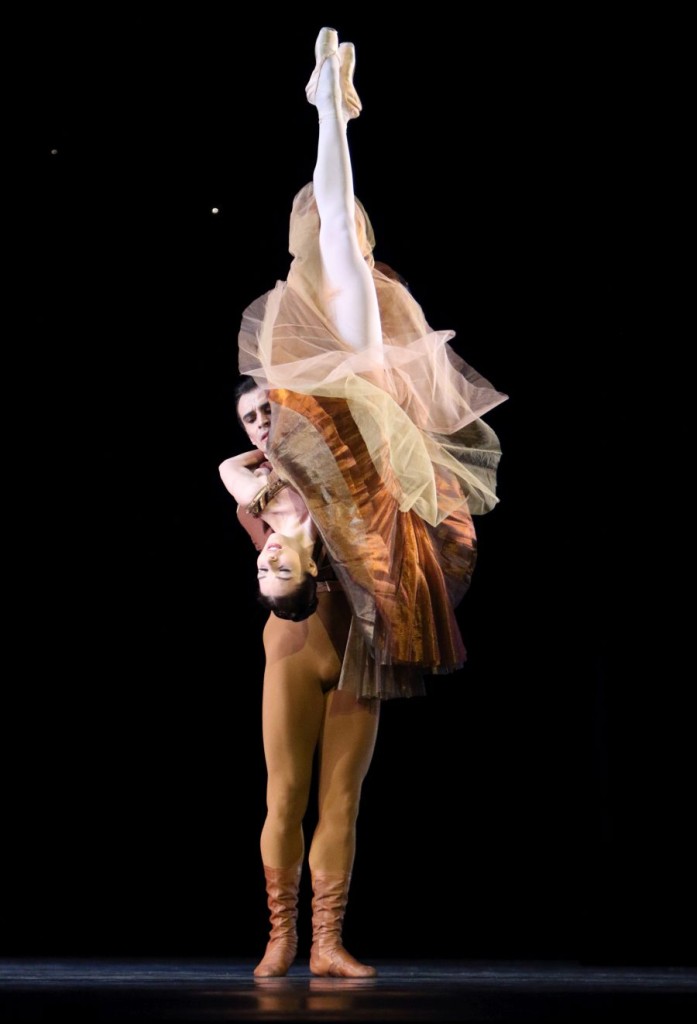
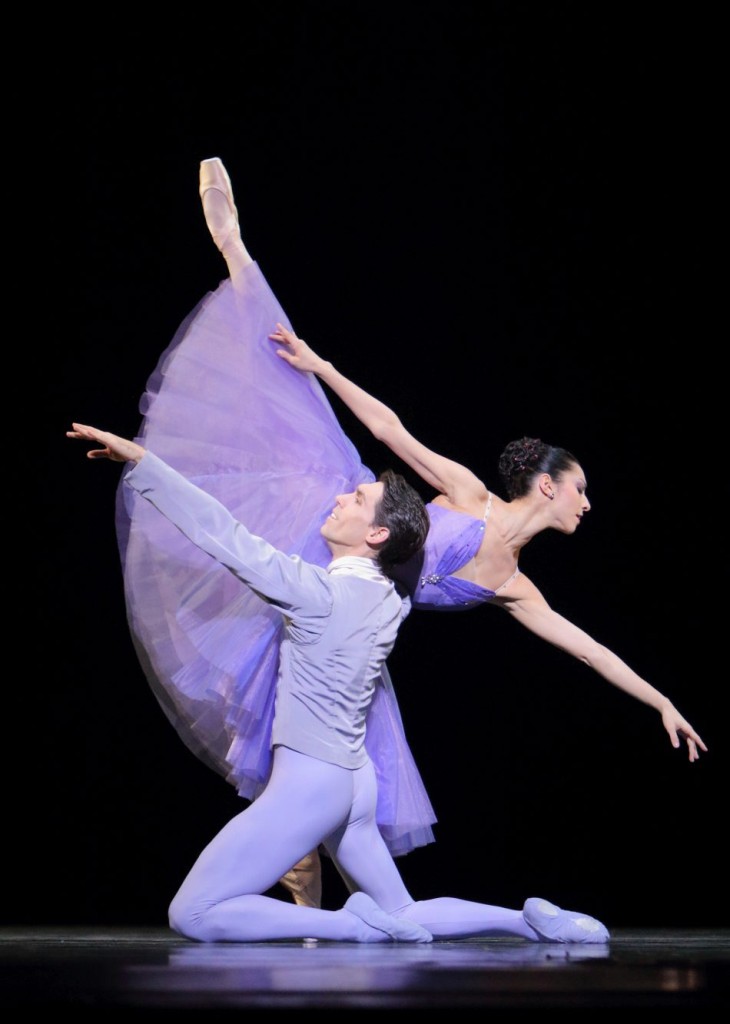 My favorite part of the evening was the middle piece, Jerome Robbins’s “In the Night” set to Frédéric Chopin’s “Nocturnes”. Its elegant costumes are by Anthony Dowell. Robbins portrays three couples whose distinctly different love affairs unfold in subsequent pas de deux under the star-strewn night sky. While the first couple dressed in violet hues seems newly enamored with each other, sweetly innocent and intoxicated by romance, the second couple’s love affair is already mature. They wear gold and rust colors. The fire still sparkles between them but, though superficially well attuned to each other, each has re-established their individual position. Conflict, quarreling and reproaches dominate the third couple’s relationship. Here the woman’s dress is dark. They can’t stand each other but can’t get along without each other either. Towards the end the three couples meet each other, dancing and socializing in various small groups before reuniting with each other and going their own way.
My favorite part of the evening was the middle piece, Jerome Robbins’s “In the Night” set to Frédéric Chopin’s “Nocturnes”. Its elegant costumes are by Anthony Dowell. Robbins portrays three couples whose distinctly different love affairs unfold in subsequent pas de deux under the star-strewn night sky. While the first couple dressed in violet hues seems newly enamored with each other, sweetly innocent and intoxicated by romance, the second couple’s love affair is already mature. They wear gold and rust colors. The fire still sparkles between them but, though superficially well attuned to each other, each has re-established their individual position. Conflict, quarreling and reproaches dominate the third couple’s relationship. Here the woman’s dress is dark. They can’t stand each other but can’t get along without each other either. Towards the end the three couples meet each other, dancing and socializing in various small groups before reuniting with each other and going their own way.
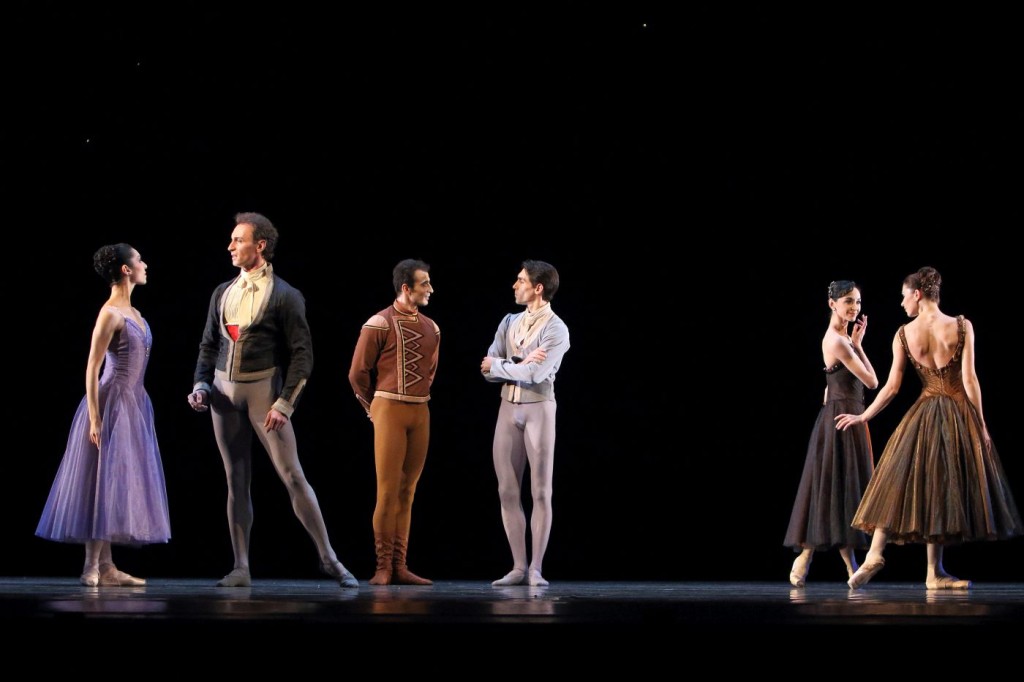 Mai Kono and Adam Zvonař danced the first couple, Ivy Amista and Tigran Mikayelyan the second while Ekaterina Petina and Matej Urban depicted the struggling couple. All three pairs were brilliant, their presence filling the stage. Music and dance melted into a unity. From the first moment on, the atmosphere was dense. One felt as if one was sitting on a park bench on a velvety, balmy night, being allowed to see into love affairs. Kono floated as light as a feather in Zvonař’s arms. Mikayelyan brought manly self-confidence to his role, matching Amista’s equally strong personality. The way he turned her upside down with one arm movement emphasized this. Petina and Urban hit every possible register
Mai Kono and Adam Zvonař danced the first couple, Ivy Amista and Tigran Mikayelyan the second while Ekaterina Petina and Matej Urban depicted the struggling couple. All three pairs were brilliant, their presence filling the stage. Music and dance melted into a unity. From the first moment on, the atmosphere was dense. One felt as if one was sitting on a park bench on a velvety, balmy night, being allowed to see into love affairs. Kono floated as light as a feather in Zvonař’s arms. Mikayelyan brought manly self-confidence to his role, matching Amista’s equally strong personality. The way he turned her upside down with one arm movement emphasized this. Petina and Urban hit every possible register 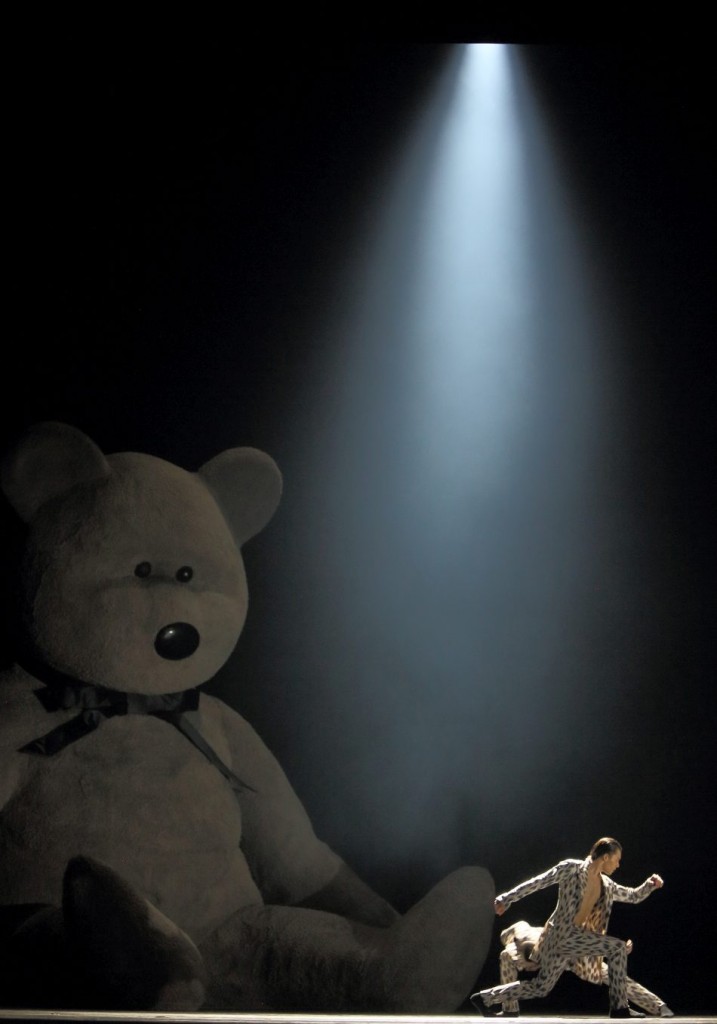 of a disharmonious love affair. He was huffy and sulking, she kicked her legs in the air when held by him to gain freedom. But, when abandoned, both felt lonely. Finally Petina, hunching up in front of Urban’s feet, offered devoted reconciliation. But how long will peace last?
of a disharmonious love affair. He was huffy and sulking, she kicked her legs in the air when held by him to gain freedom. But, when abandoned, both felt lonely. Finally Petina, hunching up in front of Urban’s feet, offered devoted reconciliation. But how long will peace last?
The evening’s third piece, “Adam is”, is Aszure Barton’s second work for the company. This time she employed an all-male cast of nine plus a super-size teddy bear, which occupies the left corner of the stage. The music, commissioned by the Canadian Curtis Robert Macdonald, mingles piano, violin and vocal sounds with acoustic bass and rhythmic percussion. Blurred black and white video projections of forest trees with rays of sunshine refracted by trunks open the scene, a foggy glade lit from above. One is reminded of Marco Goecke’s minimalistic sets, which are also often shrouded in mist, although he prefers small props, not twenty-one feet high plush monuments. Michelle Jank costumed the nine men in pants, shirts and jackets. These, white with black dots, are reminiscent of the fur of evenly spotted Dalmatians. At one point the dancers line up in front of a backdrop equally patterned.
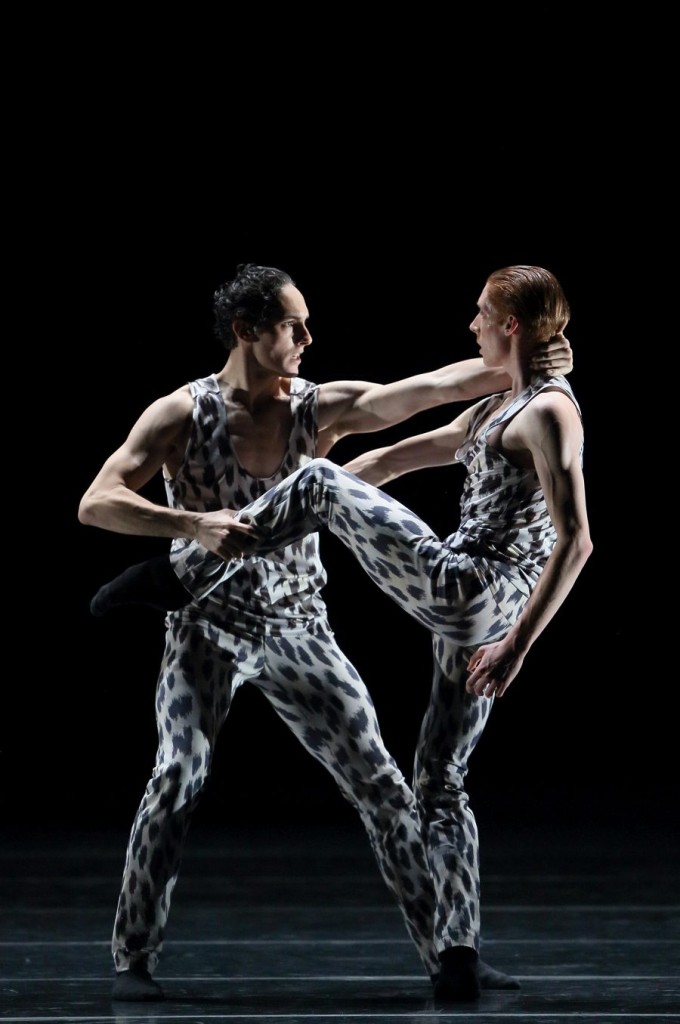
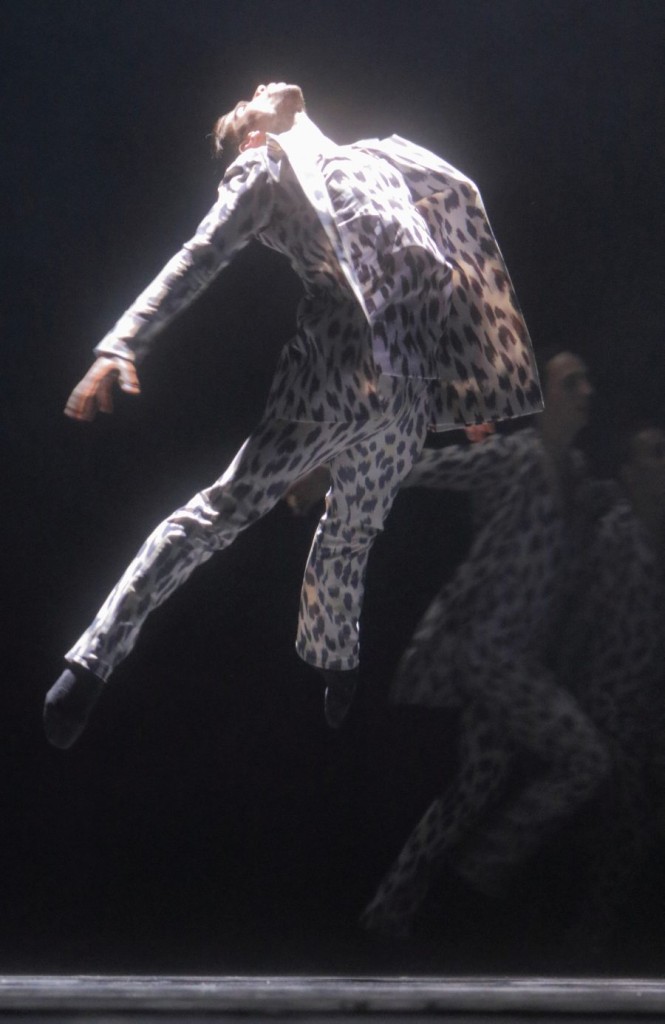 The choreography responds to the music’s pushing beats and rattling, hissing sounds. One pas de deux to harmonious piano accompaniment stood out for its flow and smooth tension within the movements. Barton draws on the common vocabulary of contemporary dance. The men kick their legs, turn, glide to the floor, walk with sloping shoulders, beat on tummy muscles or hop collectively. The latter reminds one of a tribe’s ritual dance. “Adam is” involves different stereotypes of what a man is or should be: a tough, coarse buddy but also a tender soul, not ashamed to allow his vulnerability be seen. Barton’s men climb the teddy bear like a rock. It also seems to be their refuge. Maybe they wish to take themselves back to infancy. Things got worse when the men lined up at the frontstage and performed trite moves to recorded grunting and groaning.
The choreography responds to the music’s pushing beats and rattling, hissing sounds. One pas de deux to harmonious piano accompaniment stood out for its flow and smooth tension within the movements. Barton draws on the common vocabulary of contemporary dance. The men kick their legs, turn, glide to the floor, walk with sloping shoulders, beat on tummy muscles or hop collectively. The latter reminds one of a tribe’s ritual dance. “Adam is” involves different stereotypes of what a man is or should be: a tough, coarse buddy but also a tender soul, not ashamed to allow his vulnerability be seen. Barton’s men climb the teddy bear like a rock. It also seems to be their refuge. Maybe they wish to take themselves back to infancy. Things got worse when the men lined up at the frontstage and performed trite moves to recorded grunting and groaning.
So what is Adam? An animal creature, giving free reins to basic instincts? A man involuntarily grown up and longing for his childhood days? Or a plant trying to deal with the soft side of its nature? Oh dear! If I was a male dancer working with a female choreographer in the studio on the subject of sensibility and this were to be the outcome, I would feel taken for a fool.
| Links: | Bavarian State Ballet’s Homepage | |
| Photos: | (The photos show a partially different cast from an earlier performance.) | |
| “Symphony in C” (George Balanchine) | ||
| 1. | Ensemble, “Symphony in C” by George Balanchine, Bavarian State Ballet, Munich 2015 | |
| 2. | Lucia Lacarra, Marlon Dino and ensemble, “Symphony in C” by George Balanchine, Bavarian State Ballet, Munich 2015 | |
| 3. | Ekaterina Petina, “Symphony in C” by George Balanchine, Bavarian State Ballet, Munich 2015 | |
| 4. | Erik Murzagaliyev and ensemble, “Symphony in C” by George Balanchine, Bavarian State Ballet, Munich 2015 | |
| “In the Night” (Jerome Robbins) | ||
| 5. | Ivy Amista and Javier Amo, “In the Night” by Jerome Robbins, Bavarian State Ballet, Munich 2015 | |
| 6. | Ekaterina Petina and Tigran Mikayelyan, “In the Night” by Jerome Robbins, Bavarian State Ballet, Munich 2015 | |
| 7. | Ivy Amista, Cyril Pierre, Tigran Mikayelyan, Javier Amo, Lucia Lacarra and Ekaterina Petina, “In the Night” by Jerome Robbins, Bavarian State Ballet, Munich 2015 | |
| “Adam is” (Aszure Barton) | ||
| 8. | Erik Murzagaliyev and Javier Amo, “Adam is” by Aszure Barton, Bavarian State Ballet, Munich 2015 | |
| 9. | Matej Urban and Jonah Cook, “Adam is” by Aszure Barton, Bavarian State Ballet, Munich 2015 | |
| 10. | Shawn Throop, “Adam is” by Aszure Barton, Bavarian State Ballet, Munich 2015 | |
| 11. | Léonard Engel, “Adam is” by Aszure Barton, Bavarian State Ballet, Munich 2015 | |
| all photos © Wilfried Hösl 2016 | ||
| Editing: | Laurence Smelser, George Jackson |
